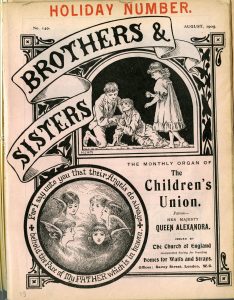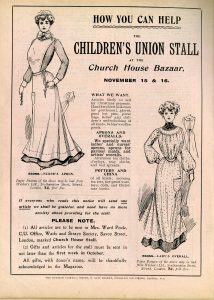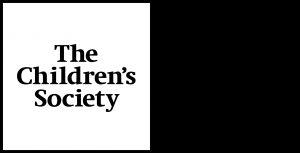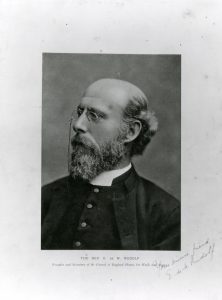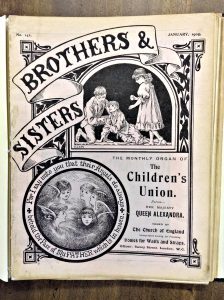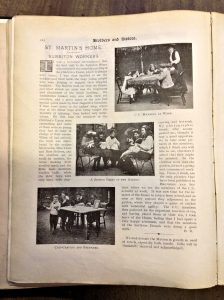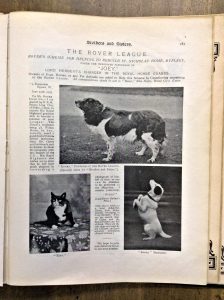The second part of a blog written by one of our volunteers, Rod Cooper, takes a look at The Children’s Society’s fundraising activity and the work of the Children’s Union – a remarkable idea that allowed children to fundraise on behalf of children! You can read part 1 here.
Another Children’s Union-wide fund-raising initiative was the Happy Birthday League. As with the Rover League, the primary aim was to raise funds for the re-building of St Nicholas’ Home. There was one very simple rule to become a member of the League and that was the submission on one’s birthday of one shilling “as a thank-offering for your preservation during the year that has past.” The monthly issues of Brothers and Sisters always carried a reminder of the League and its purpose, and occasionally there would be a small article or report. In the July 1905 issue, for example, there was a not entirely subtle reminder to avoid being overlooked by its readers: “How many birthday presents have you given this year to your friends?” By 1905, the Happy Birthday League had enrolled almost 7,000 members and it raised £335 13s. 1d. during the year; an amount equivalent to about £37,000 today.
In the August 1905 issue Mrs Rose Leck provides a report about the annual fêtes held at, and in aid of, the Bradstock Lockett Home, Southport. As mentioned in part 1, fêtes were an invaluable source of Children’s Union (C.U.) fund-raising, although larger-scale events such as that held at Bradstock Lockett also had the important function of cementing bonds between the local branches; Mrs Leck reported that she “was able to count representatives of nearly forty branches” either attending or providing attractions. It’s quite likely (and refreshing to think) the term ‘networking’ was missing from the lexicon of Edwardian England, but there is little doubt that events such as the annual Bradstock Lockett fêtes were central to engendering close personal contacts and a unity of purpose within the C.U..
Her contribution to Brother and Sisters notwithstanding, Mrs Leck’s primary role was as the Organising Secretary of the Northern Children’s Union, a reminder that the C.U. at this time, as well as being the fruit of a local, grass roots initiative, was very much a decentralised organisation. St Nicholas’, St Martin’s and St Agnes’ homes, all located in the south of England, fell within the purlieu of the Southern Children’s Union (which, as is in the nature of these things, tended to just call itself the Children’s Union). The northern branches organised themselves within the Northern Children’s Union centred on the activities of the Bradstock Lockett Home, Southport (notably named after one of its main benefactors and advocates rather than a saint) and those of the Ripon and Wakefield Dioceses which oversaw funding of St Chad’s Home, Far Headingly. The extent of local independence and discretion is hard to judge, though as an example, the Northern Children’s Union chose to adopt the Happy Birthday League a little later than its southern counterpart, and with the specific aim of covering the outstanding debt on the development of the Bradstock Lockett Home.
Branch secretaries and members of the Children’s Union could advertise their affinity with the C.U. by purchasing and wearing the C.U. badge. These were available in white metal (at 4d.) or bronze (8d.). Branch secretaries often purchased badges and awarded them to members who secured the recruitment of additional members. In the September issue there is reference to Miss Olive Dawson of Shortlands, Kent, who had suggested earlier in the year that a bar should be added (“something after the style of the Boer War medals”) as a reward for securing additional members. The report continues that another branch secretary, Mrs Elsie Clifford (Blackheath) had consequently commenced awarding a Bar for Merit to individual members of her local branch. In recognition of these initiatives – and no doubt identifying a further means of raising funds – “We [the Children’s Union administration] therefore propose to supply the ribbon and bars to be fixed to the members’ badges: and further notice, with prices etc., will be given in the next Magazine. On the bar will be the following words: –“FOR SERVICE” – and Branch Secretaries may give the bar for special service rendered by a member to the Children’s Union in obtaining new members and new subscribers to the Magazine.”
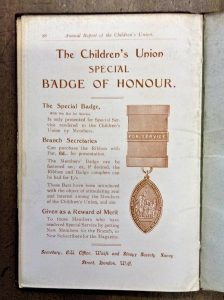 While the greater part of each issue of Brothers and Sisters comprised news from the Homes, or essays on photography and natural history, plus short-stories and puzzles, it is the shorter articles and notes, the readers’ letters and news from the branches which provide a real sense of the C.U.’s activities. In the October issue, for example, there is a short article entitled “Some Ways of Working for The Children’s Union”. This is a direct appeal to the C.U.’s membership and informs children how they may help in practical terms to produce items for ‘Sales of Work’ – a mainstay of branch fêtes and fund-raising in general. Described in a gender specific terms that wouldn’t accord with present-day mores, it suggests items of needlework for girls, whilst boys might consider “wood carving, iron-work, netting hammocks, handbags, fruit nets etc.” The impact of such activities is apparent elsewhere in the magazine; in the same issue – just as in all issues – there are a numerous reports from local branches referring to sales of work and the money raised as a consequence of children’s efforts.
While the greater part of each issue of Brothers and Sisters comprised news from the Homes, or essays on photography and natural history, plus short-stories and puzzles, it is the shorter articles and notes, the readers’ letters and news from the branches which provide a real sense of the C.U.’s activities. In the October issue, for example, there is a short article entitled “Some Ways of Working for The Children’s Union”. This is a direct appeal to the C.U.’s membership and informs children how they may help in practical terms to produce items for ‘Sales of Work’ – a mainstay of branch fêtes and fund-raising in general. Described in a gender specific terms that wouldn’t accord with present-day mores, it suggests items of needlework for girls, whilst boys might consider “wood carving, iron-work, netting hammocks, handbags, fruit nets etc.” The impact of such activities is apparent elsewhere in the magazine; in the same issue – just as in all issues – there are a numerous reports from local branches referring to sales of work and the money raised as a consequence of children’s efforts.
In addition to producing items for sale at Branch fêtes and bazaars, children were also encouraged to produce plays and entertainments. In the November 1905 issue there is a “List of Plays, Duologues &c.”, detailing scripts for short plays which could be purchased directly from their publishers for sixpence or one shilling. In the same issue, amongst the “Reports from Branches”, two branches refer to performances put on by their members. The Chelmsford Branch’s Annual Fête saw three members acting “two fairy plays, viz., ‘The Three Wishes’ and ‘Foolish Jack’” – their endeavours contributing to a total of £30 raised by the overall event. Elsewhere, the Pershore Branch reported that “two performances of the play, ‘Three Fairy Gifts,’ were given and much appreciated, supplemented by a piano duet, a skirt dance, and a duologue entitled ‘Perseverance Wins’.”
The December 1905 issue very much follows the format of the preceding eleven issues. News from the Homes is preceded by a notice from “The Crippled Children in our Homes” wishing the readers of the magazine and the members of the Children’s Union “A Happy Christmas and New Year”, and the magazine continues with its mixture of regular and feature articles, short stories, puzzles and news from the branches. Amongst the latter is a report on the C.U.’s conference at St Mary Abbot’s Church, Kensington, London. Many important figures from The Children’s Society and the Children’s Union were in attendance, including Edward Rudolf – “who gave a brief sketch of the general work of the Society” – and Lady Beatrix Wilkinson. As President of the C.U., Lady Wilkinson gave an account of the C.U.’s work from its beginning and “gave many practical hints on the management of a Branch which included among the children members of all classes.” Such words might seem patronising and anachronistic now, but when she mentions subsequently that “children can work at home or at meetings”, or that some children can put savings in boxes or collect from others, and that “ways and means of working are found to suit each Branch”, she clearly highlights that the C.U., reflecting its “spirit of endeavour and loving service”, was grounded very much at the local level with branches reflecting their own capabilities and conditions.
Branches were also encouraged to pursue their own initiatives and ideas, and to share these with fellow branches. Allowing ideas and initiatives to take root at the local level was clearly useful. It maintained enthusiasm among the members (there wasn’t the necessity of waiting for instructions from HQ), it fostered a spirit of inclusivity among the members, and a notion that all branches were of equal standing and prominence. Added to this mix were the rather straight-forward aims of the C.U.; the support of five Homes and their resident children. This combination of localism, decentralisation, inclusivity, and simple straight-forward aims, all contributed to promote the Children’s Union as a very effective means of fund-raising within fifteen years of its – arguably, quite accidental – inception.
Want to know more?
Further information on the Children’s Union Rover League can be found on the Hidden Lives Revealed website: http://www.hiddenlives.org.uk/activities/rover_league/rover_league1.html
Scanned copies of the Brothers and Sisters magazine can be found here: http://www.hiddenlives.org.uk/publications/brothers_and_sisters/index.html
Records relating to the Children’s Union featured in this blog are held at The Children’s Society Archive:
- for information about The Children’s Society Archive’s ‘Hidden Lives Revealed’ web site: http://www.hiddenlives.org.uk/
- or you can consult the Archive’s on-line catalogue: http://www.calmview.eu/childrensociety/Calmview/
If you would would like to know about how The Children’s Society continues to change children’s lives today, visit the charity’s website: http://www.childrenssociety.org.uk/
© The Children’s Society

